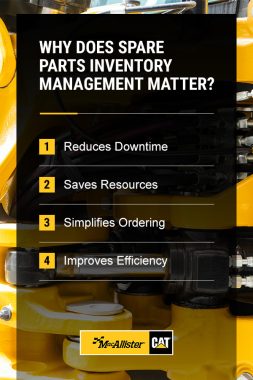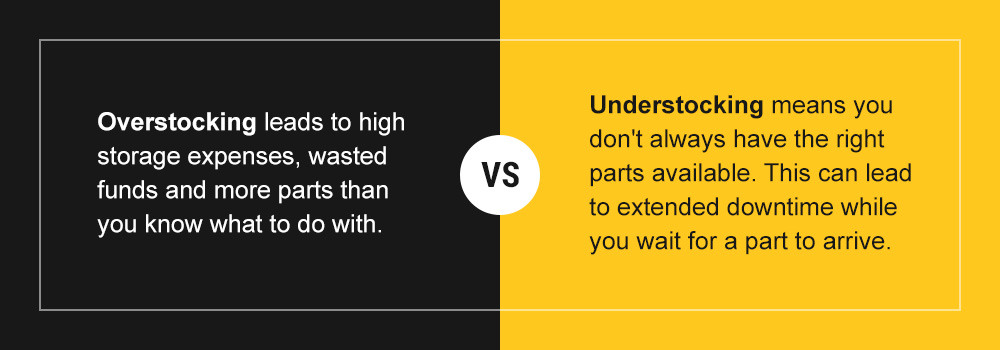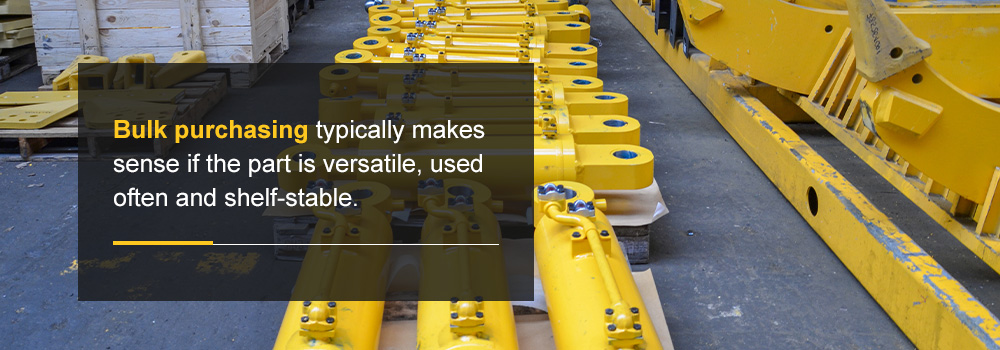
Parts make up all the equipment you use in your business. When equipment goes down, having the right spare part on hand can mean the difference between expensive downtime and a productive day.
However, it’s not enough to keep dozens of parts stocked at all times. A well-organized system ensures you have the right parts on hand without spending all your finances on inventory. Explore heavy equipment spare parts and how the right management can transform your operation below.
Jump to Sections:
- Why Does Spare Parts Inventory Management Matter?
- Common Challenges in Spare Parts Management
- How Many Parts Should You Have in Your Inventory?
- What Spare Parts Should You Always Have?
- How to Manage Your Spare Parts Inventory
- How to Optimize Your Spare Parts Log
- Ensuring Parts Availability and Reducing Fleet Downtime
Why Does Spare Parts Inventory Management Matter?
 Staying on top of inventory saves you time, money and frustration. An efficient business needs a system in place. Here’s how parts management can improve your operation:
Staying on top of inventory saves you time, money and frustration. An efficient business needs a system in place. Here’s how parts management can improve your operation:
1. Reduces Downtime
Being in the heavy equipment industry means being ready for anything. It’s common for parts to break down unexpectedly, and if you don’t have spare parts ready, you can expect extended downtime, costing you money. You might also have to pay extra to quickly ship the right component to your team.
Having an organized stock of spare parts available means repairs happen faster. The result is minimized downtime and increased productivity.
2. Saves Resources
While all fleets need spares on hand, too many parts waste storage space and tie up cash. You can’t reinvest that money on other, more important investments if you have more parts than necessary. A spare part structure lets fleet managers strike a balance. Keep the most frequently used parts while avoiding excessive stock you don’t need.
3. Simplifies Ordering
Effective parts inventory management also simplifies ordering and restocking. By tracking part use and planning for maintenance, you can predict demand before it happens. Invest in predictive tools and reliable online sellers to ensure you’re getting reputable parts on time without the hassle of manual tracking.
4. Improves Efficiency
A spare parts list keeps you more organized and efficient. When you track and order the right parts, you reduce wait time for part replacements. Your team can quickly replace damaged components without waiting for the part to arrive, improving overall efficiency. Fleet managers can minimize rush delivery costs, duplicate purchases and overstocking to make the operation run smoothly and profitably.
Common Challenges in Spare Parts Management
Managing a fleet means being responsible for every little detail. It’s not just about investing in high-quality equipment — everything should run smoothly. Even something like managing spare parts inventory comes with difficulties. Stocking is the main challenge for fleet managers, which is why effective management is so important.
Overstocking vs. Understocking
Finding the right balance between overstocking and understocking is a major challenge for businesses. Overstocking leads to high storage expenses, wasted funds and more parts than you know what to do with. However, understocking means you don’t always have the right parts available. This lack of parts can lead to extended downtime while you wait for a part to arrive.

Inefficient Inventory Tracking
Relying on spreadsheets and manual logs to track inventory is inefficient. Additionally, manual work makes it easier to misplace parts, which can lead to inventory errors. Without a clear system, you might reorder parts you already have or fail to replace critical components. Fleets should invest in a reliable, predictive system to stop these issues.
How Many Parts Should You Have in Your Inventory?
The number of parts you have depends on your needs. The goal is to stick to enough parts to avoid downtime without using all your storage space. Start by reviewing your service history and any manufacturer recommendations. Track how often parts should be replaced and any you replace more frequently. You should have enough spares for a few surprises and then stock for regular maintenance.
For example, you should keep routine parts like filters and fluids based on usage cycles. If your equipment needs a new air filter every 250 to 500 hours, and your team logs 300 hours a month on one unit, consider keeping at least two air filters on hand per equipment piece.
Emergency parts need priority, too. If you use specialized parts or components with long lead times, it’s a good idea to have them ready. Keep parts that are critical for your high-use equipment stocked.
What Spare Parts Should You Always Have?
Some parts are swapped out more than others. Start your spare inventory with these parts and build it out from there:
- Air, fluid and hydraulic filters
- Seals, o-rings and gaskets
- Fluids
- Lubricants
- Starters and batteries
- Tires and tracks
- Hoses
- Belts

These items wear out on a predictable schedule and are used for multiple equipment types. Having a solid stock ready ensures you can keep your fleet moving. Using online tools can help you keep track of all your equipment and the replacement parts each machine needs.
How to Manage Your Spare Parts Inventory
Staying ahead of equipment maintenance means having the right amount of parts on hand. Fleet managers should know what’s in the inventory, how often it’s used and what to order in the future. A solid management strategy will save you money while minimizing downtime.
Here’s how to get your spare parts inventory under control.
1. Determining the Right Quantity of Spare Parts
First, how much of each part should be stocked? The right number of spare parts depends on your fleet size, equipment use and replacement speed. Fleet managers must balance shelf space to avoid overstocking and understocking.
Start by analyzing your part use history. How often are you replacing certain parts? How many hours does your equipment run each month? What equipment needs servicing more often? Break down this data to find specific backup part quantities.
Predictive tools like VisionLink® are a great solution to this problem. VisionLink® gives you real-time insights into equipment health and forecasting part replacement. You can combine this data with part service records to find your optimal part stocking levels. Start ordering spare parts based on use, predictive needs and lead times.
2. Creating a Spare Parts Checklist
Having a checklist makes it easier to track your inventory. Spare parts checklists should cover everything from common replacements to emergency components. Break your checklist down into maintenance parts, high-wear items and emergency replacements to improve organization.
Common spare parts include filters, fuses, fluids and wear components. Most manufacturer’s guides will tell you about part replacement and frequency. Build your checklist by combining quantity data with the manufacturer’s guides to create a comprehensive list.

Once you’ve built your list, you can sort parts into these categories:
- Use: Break components down into daily, weekly and monthly use frequency.
- Importance: Separate parts that equipment can’t run without.
- Lead time: Some parts arrive faster than others. Keep products with long lead ties in stock to avoid outages.
3. Using Regular Audits
No matter how tight you run your inventory, there’s always something that slips through the cracks. Use regular audits to catch potential problems. Over time, parts are misplaced, used without logging or discontinued. Auditing helps you understand what’s actually in stock.
Your audit schedule should include checks every few months and once a year. Make sure you’re auditing a different inventory section each month. Then, yearly, do a full item count. Also, frequently check your counts for critical and high-use parts to avoid shortages. Audits will quickly catch errors or missing items.
Audits also identify slow-moving items that are taking up space. If you haven’t used a part in a year and it doesn’t support critical equipment, you can likely stop stocking it. With physical and digital tracking, you’ll keep your system efficient and cost-effective.
4. Consider Seasonality
Seasons in the Midwest can change how your fleet operates. Smart parts management means thinking ahead. Cold weather can crack hoses and seals, and batteries and fluids are more prone to failure in severely cold temperatures. During the warmer months, you’re working longer hours and seeing more frequent wear on tools like tracks and teeth.
Review your past seasonal wear patterns. The time of year can tell you what parts you’ll need and when. If you see more air filter replacements in June, you know to stock extra during that period. Order parts you historically need early so you’re ready when the weather changes.
5. Handle Slow-Moving Inventory
Even the most well-managed system might have slow-moving stock. You might have ordered parts thinking they would come in handy, only to sit unused. Sometimes, equipment is sold, and the parts remain behind on the shelf. Whatever the reason, analyze your slow-moving inventory.

Investigate your inventory turnover data. Some slow-moving components might be important if they’re rare. However, a lot of those parts can likely be removed. Part suppliers might offer returns for credit or consignment options. You could also try to resell unused parts to other fleets. Clear out any noncritical parts that have sat untouched for over a year to free up space.
Regular reorganizing is even more important if you stock parts for multiple brands. A lean inventory prevents you from hoarding obsolete parts. You’ll have more room to store your most important pieces.
How to Optimize Your Spare Parts Log
Good management is one part of a well-oiled inventory system. Once you’ve set up your inventory and got management down, it’s time to optimize it. Lowering costs and reducing waste is a great way to make your fleet more effective. With the right procurement strategies, you can make your inventory work harder without overextending your business.
1. Just-in-Time Inventory Management
Just-in-time (JIT) inventory management is an inventory strategy built around timing. JIT strategies mean ordering parts closer to when you actually need them instead of having items around “just in case.” When done right, it reduces overhead costs and frees up space.
JIT focuses on preventing downtime while avoiding cutting corners. Fleet managers can use data to plan. For example, VisionLink® doesn’t just help you predict part demand — it actively monitors equipment condition. This information makes it easier to bring your fleet in for maintenance before it breaks down. You avoid needing critical emergency components and can easily keep maintenance parts on hand.
However, not everything needs to be ordered this way. High-failure components or parts that take longer to arrive need advance stocking. Sometimes, ordering just in time leaves you with empty stock. Try to balance a JIT strategy with in-stock parts to keep your operation running.
2. Bulk Purchases
Buying in bulk can reduce your costs per part and minimize shipping fees. Part suppliers often offer deals for bulk orders, giving you a much-needed cost reduction. However, bulk orders only save money if you use all the components. Over-ordering to get a bulk discount leads to wasted storage space and outdated inventory.
Bulk purchasing typically makes sense if the part is versatile, used often and shelf-stable. Some parts degrade in storage — try to avoid bulk ordering these items. Similarly, bulk buying specialized parts is a poor use of your finances. Specialized parts don’t work across the fleet, meaning you’d be tying up shelf space and cash flow.

Use bulk orders for common parts like belts, filters and fluids. Remember to still keep track of your bulk orders to ensure you’re not over-ordering or letting parts expire on the shelf.
3. Streamlining Procurement
Getting parts quickly and reliably is another way to optimize inventory. You could have the best inventory tracking in the world — without a reliable parts supplier, you won’t be able to prevent downtime. Partner with established suppliers that can connect you to the best-quality components.
Your chosen suppliers should have parts for the brands you use, as well as warranties and additional services. Suppliers with 95% parts availability have a wide range of parts available within 24 hours, helping you prevent downtime and get back in action sooner. Quality suppliers will offer exchange components and online parts ordering to help you maximize your operation. With fewer ordering delays, you can keep your inventory well-managed.
4. Invest in Equipment Standardization
If you’ve been expanding your fleet over the years, it’s common to have a mix of equipment. Each brand might require different filters, fluids and service kits. Fleet standardization is the answer to managing this complex system.
Standardizing your fleet helps you save money in the long run. Your most high-use equipment should be part of a consistent lineup to make stocking more accurate and efficient. No more finding the right air filter for the brand — everything uses the same brand filter. You’ll reduce expenses and clear up the stock room.
Standardization also makes training and servicing easier. Technicians can become experts faster if they’re only working with one brand. You can establish a more consistent maintenance schedule for your fleet, too.
5. Support Your Technicians
Technicians are a major support in your inventory process. They’re the first to notice issues with a component. If it’s a problem across multiple units, they can alert you to a more serious issue before it brings down the entire fleet.

Give your team a way to share feedback and update the inventory. Let them access the heavy equipment spare parts list to log what parts they used, when and why. With lots of details from your technicians, preventing understocking and emergency orders is easier.
6. Build Strong Supplier Relationships
Go beyond picking good parts suppliers — create a supplier network that works for your entire business. Long-term relationships with trusted suppliers can lead to better pricing, faster service and more flexibility. Look for dealers that sell parts and more. These dealers can recommend the right stocking levels, provide field service and support your operation.
The right supplier can go above and beyond, giving you an all-in-one experience. Rent equipment, get deals and enjoy comprehensive equipment servicing without going to multiple shops. A reliable, multi-stop supplier can become a true partner in building your business.
Ensuring Parts Availability and Reducing Fleet Downtime
Every moment your equipment sits is a moment of lost productivity. Predictive and preventive maintenance are some of the best ways to increase uptime. Here’s how to use them to your advantage.
Predictive Maintenance for Proactive Management
Predictive maintenance is all about using data to spot wear and failure before they happen. Instead of waiting for a component to fail, predictive systems flag issues when they start. You get time to fix the problem and prevent equipment shutdown. This approach also extends equipment life.

Tools like VisionLink® are designed specifically to help with proactive management. They monitor equipment health, usage hours, fault codes and fluid levels. You get real-time performance tracking and alerts, which helps you avoid equipment failure. VisionLink® gives you the chance to schedule repairs at a time that works for your crew.
Preventive Maintenance Planning
While predictive tools use data, you still have to stay on top of practical work like maintenance. Preventive maintenance is essential to keeping your fleet in top condition. With the right maintenance at the right time, you extend equipment life and avoid sudden failures.
Most equipment comes with clear service intervals for all maintenance tasks. Stick to these intervals to prevent wear from turning into bigger issues and emergency part orders. Investing in a preventive maintenance program ensures your equipment gets the attention it needs.
Preventive maintenance also keeps you from panic buying. When service is scheduled in advance, you can order the necessary parts through JIT or confirm they’re in your inventory. That way, there’s no waiting around when it’s time for service. Make sure to stagger your maintenance windows to avoid running out of parts or slowing down your team too much.
Discover the MacAllister Difference
Keeping your fleet running means having the right parts on hand. MacAllister Machinery makes balancing inventory and profit easy for fleet managers. With access to one of the largest Cat® spare parts inventories in the region and support for other leading brands, we have the services and products to help businesses stay productive. From reliable heavy machinery rentals to our comprehensive equipment services, we’re here to help.
Find a MacAllister Machinery location near you or explore parts online today to get your inventory ready for anything!

